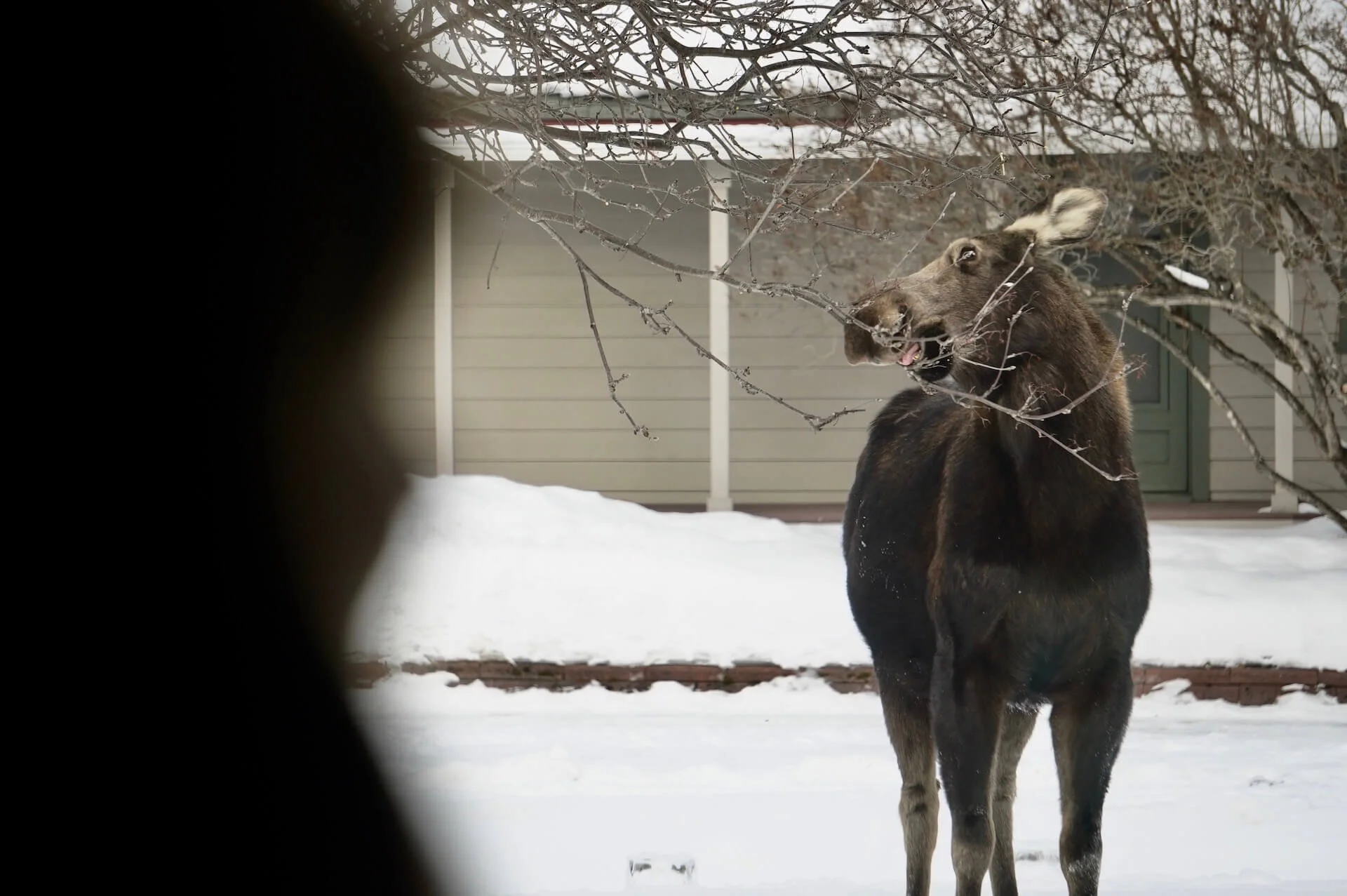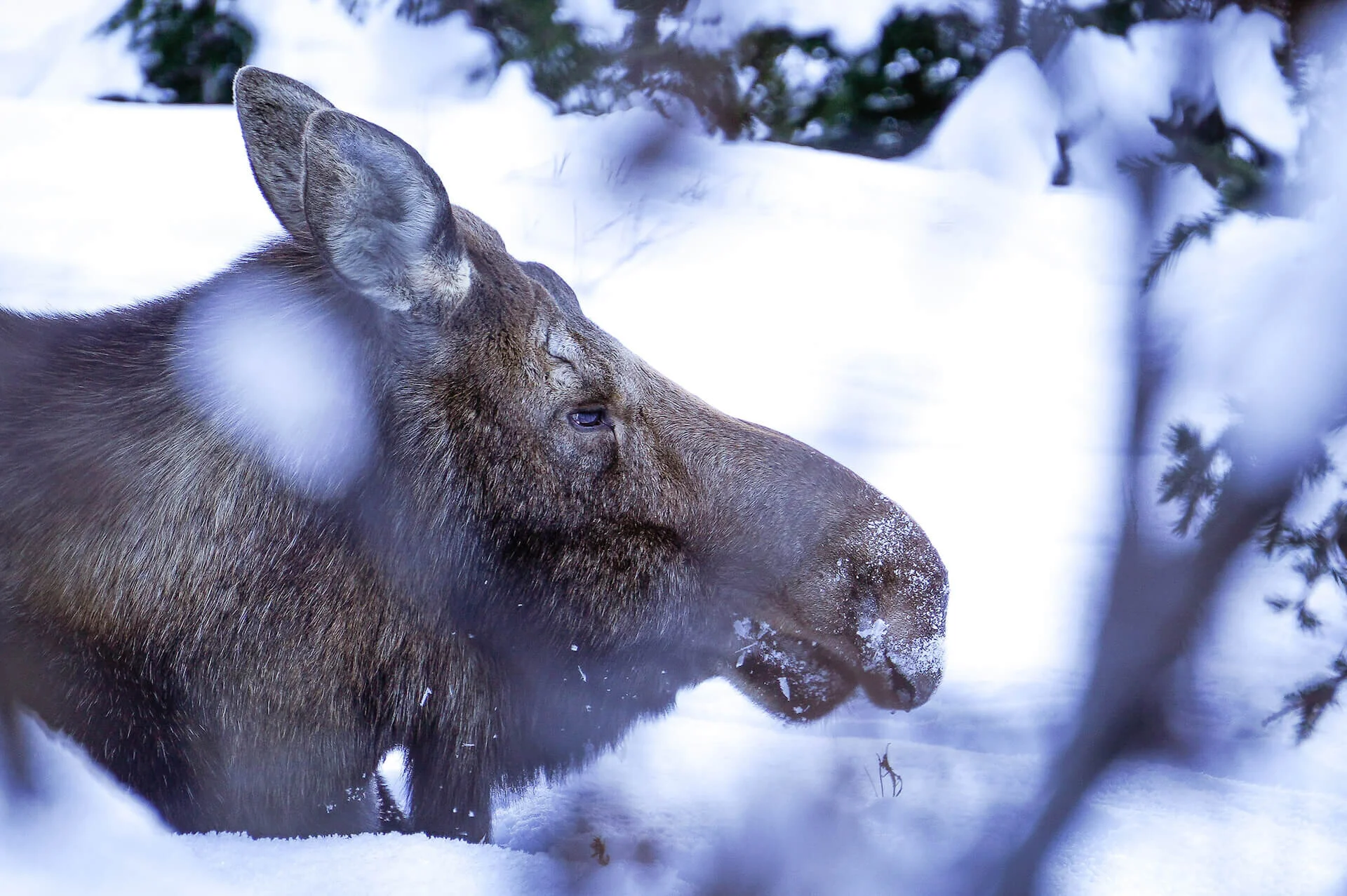Where to See Moose in Alaska
A moose visiting our front yard in Anchorage, Alaska
Moose are one of the most commonly seen large mammals in Alaska. You can find them almost anywhere you go across the state. To improve your chances of seeing one (or ten!), know that moose are most active during the summer in the early morning and evening. They don’t enjoy the heat, so they tend to hide in the forest during the day to preserve their energy. During the winter, it is a different story. Moose are more commonly seen around the city, and you will regularly see moose poop scattered across the sidewalks and yards.
Moose are an active part of our community. You can see moose in Alaska in Fairbanks, Talkeetna, Denali National Park, Palmer, and even Downton Anchorage! In this article, you will find the best locations for moose viewing, many fun facts about moose in Alaska, and information on moose safety. We hope you find this text helpful and very a-moosing!
Where to Find Moose in Anchorage, Alaska
Here are some of our favorite spots for moose viewing in Anchorage:
Kincaid is the largest park in Anchorage. Most of the park is forested and covered with trees. It is a moose paradise! If you want to see a moose here, your best bet is to start walking one of the park’s many trails.
We love biking on the Coastal Trail in Anchorage in winter and summer. Earthquake Park is a small park along this trail where Alaska moose love to hang out.
Point Woronzof Park
Between Point Woronzof and Kincaid Park, there is a beautiful forested area called Woronzof Park. This park is also part of the Coastal Trail and is a great spot to find Alaska Moose.
A mountain area called Glen Alps is just a 20-minute drive from Downtown Anchorage. It is a prime Alaska moose viewing spot! From here, you can walk along the popular Powerline Pass trail, which seems to be the moose’s favorite trail, too! You might be very lucky if you visit Alaska in September, October, or November. We have often seen more than a dozen moose grouped here simultaneously.
Daily Parking Fee: $5 per car (card or cash)
Potter Marsh is a part of the Anchorage Coastal Wildlife Refuge and is a well-known location for bird watchers. We have only seen a moose here one time, but locals swear that it is one of the best spots to watch them. Potter Marsh is a wetland area with a wooden boardwalk. It is right beside the Seward Highway, so you should stop on your way down to Girdwood or Seward.
This is a guaranteed moose viewing spot around Anchorage. It is just a beautiful hour's drive from the city, and here you will find moose that have been orphaned or recused. There are many other animals here, including bears, bison, caribou, and more! This is a great place to visit for families with kids.
Read more about fun things to do around Anchorage with kids.
Alaska Moose -The Symbol of Alaska
The Alaska Moose is the official Alaska State Mammal and one of our state's most commonly seen animals. They are found practically everywhere throughout the state (with the exception of some regions in Southeast Alaska), and they even are found in densely populated neighborhoods. For this reason, we often cross paths with moose.
The Alaska Moose and the Kamchatka Moose are the largest subspecies of moose in the world. Their size is very impressive. Bulls often exceed 6 feet in height, and the weight of these massive males can reach up to 1 ton.
According to the Alaska Department of Fish and Game, the moose population in Alaska is estimated to be around 200,000. They are not an endangered species in Alaska. Locals go moose hunting every Autumn and harvest fresh meat to supplement their diet. One large male can provide over 450 pounds of meat. Several thousand animals are hunted in Alaska yearly, most of which go to local residents, although there are some hunters from outside the state.
Valuable Moose Antlers
Beautiful bull resting in the Chugach Mountains
What often attracts hunters from outside of Alaska are the impressive moose antlers. Bulls from Alaska have the largest antlers in North America, which can grow to over 6 feet and weigh up to 90 pounds. The moose antlers reach their largest size when the animal is 6 - 12 years old. We are not hunters, but there is an interesting activity called “Shed Hunting,” where people search for antlers on the ground that have been shed by the bulls in winter.
Alaska Moose Diet
Elizabeth watching a moose through our window.
We are always impressed by how moose can reach such an incredible size based on their diet. They are geniuses in survival and can find nutrition, even in the smallest amounts. When we see moose in the winter, they only munch on dry twigs and frozen bushes.
The moose in Alaska seem to try whatever comes their way. They eat leaves, grasses, weeds, fruit, and twigs. They chew on them continuously while strolling around the neighborhoods. Moose can also be found with their heads in the water, eating the vegetation that grows from the bottom. Moose can hold their breath for up to one minute, and nature has equipped their nose with a fantastic mechanism that prevents water from penetrating their nostrils. They can even dive several yards below the surface. Pretty incredible, right?
It’s no wonder moose try to chew on anything. They must consume up to 50 pounds of food daily to maintain their impressive size. Sharp incisors in the lower jaw and tough gums and tongue allow them to break sticks. They are also champions in preserving energy. These animals usually walk along paths calmly, not particularly worried about human presence. In the winter, they are happy to visit our cities, including Anchorage, where the number of moose reaches one thousand. During the coldest months, we encounter them practically every day. They look into our windows, eat branches, and walk along the same sidewalks as people. By doing this, they do not have to waste valuable energy struggling through huge snowdrifts.
Alaska Moose Challenges
A resting moose in Anchorage
The life of an Alaska Moose is a challenging one.
It is a constant struggle for food, which is very hard to come by in the winter in Alaska. Moose in the city also become victims of collisions with cars, which is clearly indicated by the numerous signs on the highways warning “Watch for Moose” or “Give Moose a Break.” In addition to hunters vying for their meat and antlers, they are also attractive targets for several predator species, including bears and wolves. Moose have to be on alert at all times.
As if this wasn’t enough, there are also problems that humans do not yet fully understand. Moose are animals adapted to living in cold conditions. The warming climate may be perilous for them. It is also possible that moose will migrate to cooler areas, which may affect the local ecosystems. In several regions of the United States, scientists already associate the decline in the moose population with an increase in temperature.
Are Moose in Alaska Dangerous?
Moose blocking bikers on Powerline Pass trail in Anchorage, Alaska
Imagine You are going for a stroll in the park when suddenly, two policemen stop and inform you that you have to wait because there is a moose family on the trail. Yes - these situations happen in Alaska quite often.
Although these animals may seem calm, slow, sluggish, or bored at first, in Alaska, more accidents occur with a moose than a bear. In most cases, the moose usually choose to run away, but they can also become aggressive, especially if moose calves are present.
Moose show aggression when they feel threatened. They can also be irritated by hunger or fatigue. The most dangerous are cows (an adult female moose) with calves (a baby moose). Bulls (a male moose) are the most aggressive in the autumn during the rut - their mating season. During this time, it is better to watch them from a distance.
What to Do if You See a Moose
As always, do not panic or make sudden movements when meeting wildlife.
Always keep food a safe distance from the animal (at least 50 feet). If a moose blocks your way, do not disturb it. Give it space and time. You may have to wait for some time, but patience is key.
Remember that a charging moose is much faster than people, and a meeting with its running body may end tragically. However, if you find yourself in a difficult situation and the moose aggressively moves toward you, you need to find some type of cover. This might be standing behind a car or a tree.
Enjoy Moose Watching in Alaska
As mentioned before, there are a lot of moose in Alaska, so there is a very high chance that you will spot a few of them during your trip to Alaska. But of course, there is no guarantee.
We see moose in Anchorage very often, and that is because we spend most of our time here. In the winter, we meet them on our sidewalks and outside our house; in the spring, they often block our bicycle paths in local parks; in the autumn, dozens of moose can be found in the mountains surrounding our city. Moose are just a part of living in Alaska.
Moose can also often be found around Talkeetna, Denali National Park, Fairbanks, and Homer. We don’t often see them in Cooper Landing or Girdwood, which may result from a large number of bears or simply a matter of coincidence.
When traveling to Alaska, your chances of seeing a moose are high. To do this safely, you should always keep your eyes open and follow basic safety precautions.
Read more about family-friendly trails in Alaska.







